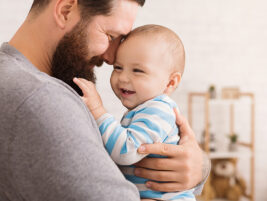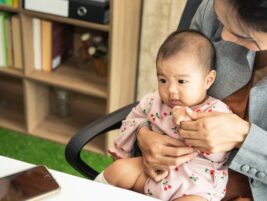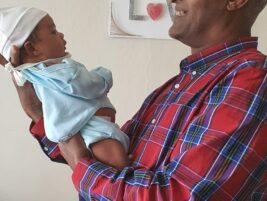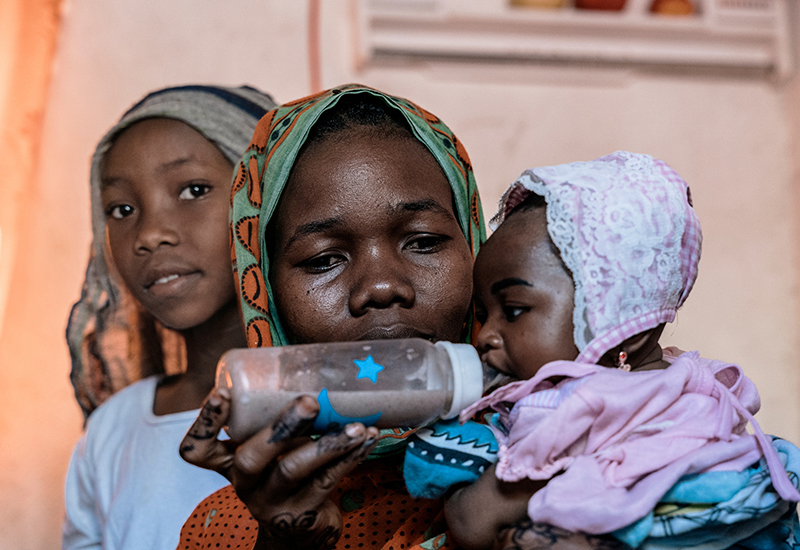Introduction
South Africa prides itself in having one of the most liberal Constitutions in the world, one where the right of every one, including children is emphasized and treasured. The country’ s laws are aligned with this Constitution. However, it is not always possible to implement these in a way that would honour the spirit of the Constitution. This is particularly so when it comes to the care of young children. The following description of a common clinical situation will highlight the difficulties encountered. The conflict that surrounded this case was due to two seemingly opposing legal positions that the professionals represented. A resolution of the conflict could have occurred earlier had there been a more in-depth understanding of the young child’ s early attachment relationships.
Background
Violence is defined “as the intentional use of physical force or power, threatened or actual that results or is likely to result in injury, death, psychological harm, mal-development or deprivation” by The World Report on Violence and Health (Daher, 2002)(p.5). In South Africa violence against infants and young children is high. The reasons for this are multi-layered and include lack of economic development resulting in poverty and the consequent loss of parental self-worth, parental substance abuse and familial patterns of child maltreatment. All of these come on the background of a violent past that enforced separation on the basis of race, resulting in unequal distribution of resources. The laws of the Apartheid State led to a division between the white minority’ s relative wealth and the black majority’ s poverty in terms of governmental service provision. This left the country with a legacy of an inferior educational system for children of colour (though this is slowly changing) as well as an unequal health system that is now gradually trying to transform into an equal delivery of skills and health facilities. However, the institutionalized oppression for over half a century has left its mark in the collective psyche. Violent acting-out is rife and, as is the case in many societies, the children bear the brunt of the adults’ anger This inter-generational violence manifests in all population groups and is not confined to the formerly oppressed group. However, abuse occurs more frequently in the context of poverty, unemployment and social deprivation (Richter Linda; Dawes Andrew, 2008). These social ills affect the majority of the Black African and so-called “Coloured” groupings. Thus, while most studies do not differentiate between the races when it comes to studying abuse, the implication is that the previously oppressed groups are affected the most.
While it is difficult to ascertain exactly how many children are suffering from abuse, there is no ambiguity when it comes to counting how many children have died because of non-accidental injuries. In a retrospective mortuary based survey of 2009, (Mathews S, Abrahamas N, Jewkes R, Martin LJ, 2012) found that the highest rate of children being killed was from 0-4 years with another peak during adolescence.
“Nearly half (44.6%) of the homicides were due to child abuse and neglect. Over a third (35.7%) of child abuse was due to abandonment within the first week after birth. Almost three quarters of these cases (74%) occurred among children aged 0-4 years and in this age group 54.5% of cases were of girls.” P 3 (Mathews S, Abrahamas N, Jewkes R, Martin LJ, 2012)
The authors conclude that
“As a country we are failing our children, current policies and practises in relation to the protection of children are having little effect in keeping children safe in their homes and communities.” (p.3)
The authors make a plea for a national response to the problem of child deaths through homicide and a four-pronged approach is suggested. The four areas for action are
- Increasing or strengthening social welfare responses to child abuse and neglect
- Intervention and Prevention initiatives
- Increasing or strengthening health service’ s response
- Increasing or strengthening the medico-legal system’ s response
The above are pleas made to various governmental sectors that are involved in the caring of children and families, including the Department of Social Development, the Criminal Justice System, the Law Enforcement System and the Department of Health.
In the Western Cape Province of South Africa, a new initiative called “The First 1000 Days”is being promulgated. Its aim is creating public awareness of the importance of a healthy start to life. Its great challenge and potential strength lies in the fact that it is co-ordinating and pulling together the various governmental sectors – health, social development, and education departments.
It will however take time before these messages filter down into the communities on the ground before the whole of the population of the very young will experience a better beginning to their lives. Parents may not be able to give their children what they need, and the responsibility then falls on the State when children are declared in need of care. The South African child welfare system is however under pressure with an urgent need for funding and human resources. (Schmid, 2012) Added to this “crisis” (p4) of lack of human resources to intervene in abusive situations, is the challenge of identifying emotional abuse. This form of abuse is said to be common, under-recognized and difficult to define (Glaser, 2002), but can have devastating effects, leading to an impairment in the child’ s functioning.
Personal clinical experience over many years attests to the fact that the emotional abuse cases are the ones that are referred to the mental health services and it is with these emotional abuse cases that there is a particular challenge. The scars are less visible, and often it is a matter of the child’ s word against an adult’ s. Mostly, the child loses out because of being deemed an ‘ unreliable witness’ . In terms of legislation however, South Africa’ s children should receive adequate protection from abuse and neglect, including emotional abuse.
The rights of the South African child are enshrined in the South African Constitution which in turn is based on four international Conventions: International Covenant on Civil and Political Rights (UN, 1966)(link 1); African Charter on Human and People’ s Rights (1981)¹; United Nations Convention on the Rights of the Child (1989)(link 2) and African Charter on the Rights and Welfare of the Child (1990)(link 3). Out of these has arisen the Children’ s Act (link 4) which protects the rights of the child at a national level. (links at the end of the article)
The state bears 3 levels of obligations to children. The prevention of violence is the first: “Every child has the right to be protected from maltreatment, neglect, abuse or degradation” (Section 28(1)(d)). The provision of protection from further harm and the support and treatment of those who have experienced violence are the other two obligations. The Act further states that “Every child has the right to family care, or parental care (Section 28(1)(b))(Mathews S, Jamieson L, Lake L, Smith C 2014) (p. 44). The balance between these two rights, namely the right to protection and the right to family care, are frequently in conflict when it comes down to a practical, clinical level. This conflict manifests between the social workers who are given the task of providing a supportive intervention for the family and re-uniting the child with its family at all costs, and the mental health professional, as the spokesperson for the child, who may guard against re-unification for various reasons. It is most frequently about the mental health or lack thereof of the parent and the child’ s attachment relationships to non-parental figures.
There is however a caveat that needs mentioning for the local situation. In South Africa there could be more at play than lack of understanding on part of the magistrates (who are the first legal port of call) of the importance of the continuity of care. These motives for reunification have to be appreciated against the backdrop of a political past where families were separated by cruel Apartheid laws. We could now be dealing with a ‘ reaction formation’ against these laws by wishing to reunite families at all cost, often to the detriment of the child concerned, as this clinical vignette will illustrate.
The clinical vignette
The toddler, whom we shall name B, was brought to the Parent-Infant Mental Health Service by her foster mother. She was 30 months of age at the time. The foster mother had cared for her since she was 2 weeks old. The referring doctor was concerned about the aggression that had manifested since her biological mother’ s return into her life, after not having had any contact over the past year. B also presented crying episodes that lasted for hours, and had sleep difficulties. The doctor also expressed concerns that B’ s mother had mental health problems that resulted in her lack of consistency and emotional outbursts. What followed this initial referral was a 10-year battle between various governmental sectors. The Social Development Department continued to recommend and insist on B returning to her mother and the Department of Health voiced concern about the child’ s responses and her explicit wish not to be separated from her foster mother.
There were obvious indications that the biological mother’ s state of mind was negatively affecting this little girl – her behavior fluctuated according to the contact she had with her biological mother, culminating in a serious suicide attempt at the age of 10 years. Once she was old enough the child stated that she was scared of mother’ s latest partner (who had a criminal record for domestic violence), and that she did not want to live with her mother. Despite these facts, the social workers pursued the line of reunification. The child psychiatric reports did not seem to carry much weight with this sector. However, the legal counsel whom the foster mother was finally able to instruct, used the reports and eventually, after much anxiety and fear, including threats by the biological mother and her partner towards the health professionals involved, the case was handed to a family law specialist, called the Family Advocate.
The office of the Family Advocate was established in 1990 to look after the wellbeing or needs of under aged or dependent children in divorce matters. The role of the Family Advocate is to assist the courts in establishing the best interests of minor children in civil legal disputes. The reports and recommendations made by the Family Advocate enable the court to evaluate the settlement reached by the parties and to establish whether it is in the best interest of the children. In certain instances the Family Advocate assists the courts in matters relating to domestic violence and maintenance (DoJ, 2017).
This path should have been taken much earlier in this child’ s life as it would have prevented the distress and anxiety experienced by all involved, including the biological parent, the foster mother and child. In this case, the Family Advocate ruled that the child was to remain with his foster mother until the age of 18 years and that the court hearings were to come to an end. The child’ s symptoms resolved almost immediately.
International trends
While dealing with this case and particularly given the threats that were aimed at us by the biological mother’ s partner, consultations with colleagues abroad took place as to the legal position in their countries. In Victoria, Australia, a law is being promulgated or by now has already been promulgated that:
“ensure[s] that the children’ s court makes a permanent plan for all children who are out of the care of their parents because of abuse or neglect. The court will be required to make an order within 12 monthsof the child being initially removed from their parents care. The aim of the law proposed is to ensure that children have certainty with their care over time, and within a relatively short time of having been initially removed from the care of their parents.” (Campbell Paul, Melbourne, August 2014, personal communication)
From the State of Michigan, USA, the Michigan Department of Human Services and the Michigan Association for Infant Mental Health issued a joint policy statement for best practices related to infants and toddlers in foster care. Among the many recommendations the statement called for:
Whenever possible, when reunification is not anticipated, infants/toddlers should be placed in foster homes that are interested in adoption–“first placement is the last placement.”(MAIMH, 2014)
The above are in line with the work done by the Attachment Clinic developed by Gauthier and his team in Montreal (Gauthier, Fortin, & Jéliu, 2004). This Clinic offers consultations to children and their families who are experiencing difficulties related to foster care arrangements, multiple displacements or threatened loss of the attachment figure for administrative or judiciary reasons. The consultations last for over 3 hours and consist of observations and assessment of the child with all the parents involved, with a focus on the quality of the child’ s attachment to both sets of parents, biological and foster parents.
Attachment theory proved to be a useful background to the discussions and recommendations given to each case. The following guidelines were developed: (Gauthier et al., 2004)
- There is a critical time for establishing attachment ties– between 8 and 18-24 months; that is, before 2 years.
- Continuity of parental figures is essential for healthy development. Rupture of attachment ties is experienced as a trauma, particularly if this is repeated.
- Progressive reintegration back into the biological family may constitute a severe trauma, particularly if the foster parents have become the ‘ psychological parents ‘ whom the children has learnt to trust. Reactions such as separation anxiety, angry outbursts and destructive behaviours are often the consequence of such a process. Often the team made the recommendation that the child remain in the foster home and not be integrated into his/her biological family
- Should an adoption become a possibility, transfer from a foster family to an adoptive family should only be considered if the infant is less than 12 months old.
The longer the child has been with the foster placement, the deeper the attachment and security with that ‘ psychological parent’ will be, making reintegration with the biological parent more difficult and risky, as was the case with the little girl presented here. An additional point that is worth noting is that while children in distress are frequently referred for psychotherapy, these efforts will be of little effect if continuity of parenting is not assured. The role of the therapist in the case presented was that of a containing function for foster mother, and to be a voice for the child in the face of adult demands and pressures. It was not about individual psychotherapy with the aim of resolving inner conflicts. However, the central point in dealing with infants and toddlers is that a “child’ s time” in the crucial early years is much shorter than the “adult’ s time:” A young child cannot wait for the parents to solve their persistent personality problems, childhood traumas, drug abuse, and violence. A child cannot be put “on hold.” p. 394(Gauthier et al., 2004)
Infant Rights
The World Association for Infant Mental Health issued a position statement in 2014. This position paper highlights the special needs of infants and toddlers. It is divided into two parts: seven Basic Principles of Infant Rights that should be endorsed globally, and ten Social and Health Policy Areas that are informed by these principles, but are more context-dependent (WAIMH, 2016).
The second Basic Principle states that
“Caregiving relationships that are sensitive and responsive to infant needs are critical to human development and thereby constitute a basic right of infancy. The Infant therefore has the right to have his/her most important primary caregiver relationships recognized and understood, with the continuity of attachment valued and protected— especially in circumstances of parental separation and loss. This implies giving attention to unique ways that infants express themselves and educating mothers, fathers, caregivers and professionals in their recognition of relationship-based attachment behaviors.” (highlights mine)
Furthermore, the related policy area that informs this Principle should “minimize changes in caregiver during the early years of development”.
In the case vignette given, the above principle was heeded much too late in this child’ s life –it remains to be seen how the continual threat of removal from the attachment figure and placement with the biological parent will impact on her as she grows up.
If the right of the infant to have her most important primary caregiver relationship recognized and protected, the suffering that the young child and her foster mother had to endure could have been prevented. The child’ s suicide attempt was the most visible manifestation of the great inner turmoil this little girl had to endure. The importance and the depth of the relationship to the foster mother was not appreciated by the social workers who were set on re-unifying the child with her mother, almost at all costs. It is the misconception that the biological parent has an ‘ in-born’ right to claim the child, irrespective of how long the separation during infancy might have been. It is this misunderstanding that needs to be re-evaluated and re-worked in the education and in-service training of those who determine the fate of these unfortunate children.
Sadly, there remain many little children of all races in South Africa who are victims not only of domestic violence, but also of legally induced disrupted attachments. It is our job to continue to speak out for them. It is hoped that the Infant Rights Position Paper, as well as the First 1000 Days Initiative in the Western Cape, will increase awareness of the special needs of all infants and young children. As Nelson Mandela reminds us in the Foreword to the World Report on violence and health (Daher, 2002):
“Less visible, but even more widespread, is the legacy of day-to-day, individual suffering. It is the pain of children who are abused by people who should protect them…” He ends it thus: “We owe our children – the most vulnerable citizens in any society – a life free from violence and fear. In order to ensure this, we must be tireless in our efforts not only to attain peace, justice and prosperity for countries, but also for communities and members of the same family. We must address the roots of violence. Only then will we transform the past century’ s legacy from a crushing burden into a cautionary lesson.(p.ix)
References
Daher, M. (2002). World report on violence and health. Le Journal Médical Libanais. The Lebanese Medical Journal, 51(2), 59–63. https://doi.org/10.1136/ip.9.1.93
DoJ. (2017). The Office of the Family Advocate.
Gauthier, Y., Fortin, G., & Jéliu, G. (2004). Clinical application of attachment theory in permanency planning for children in foster care: The importance of continuity of care. Infant Mental Health Journal, 25(4), 379–396. https://doi.org/10.1002/imhj.20012
Glaser, D. (2002). Emotional abuse and neglect (psychological maltreatment): A conceptual framework. Child Abuse and Neglect, 26(6–7), 697–714. https://doi.org/10.1016/S0145-2134(02)00342-3
MAIMH. (2014). MICHIGAN DEPARTMENT OF HUMAN SERVICES AND MICHIGAN ASSOCIATION FOR INFANT MENTAL HEALTH JOINT POLICY STATEMENT ONATTACHMENT IN INFANCY AND BEST PRACTICE RECOMMENDATIONS FOR DECISION- MAKING FOR INFANTS / TODDLERS IN FOSTER CARE Infants / Toddlers Placed.
Mathews S, Abrahamas N, Jewkes R, Martin LJ, L. C. (2012). Child homicide patterns in South Africa: South African Medical Research Council, (August), 1–4.
Mathews S, Jamieson L, Lake L, S. C. (2014). South African Child Gauge.
Richter Linda; Dawes Andrew. (2008). Child Abuse in South Africa: Rights and Wrongs. Child Abuse Review, 79–93.
Schmid, J. (2012). Trends in South African Child Welfare from 2001-2010.
UN. (1966). International Covenant on Civil and Political Rights.
WAIMH. (2016). WAIMH Position Paper on the Rights of Infants (Vol. 2014).
Links
Link 1: https://www.humanrights.se/wp-content/uploads/2012/01/African-Charter-on-Human-and-Peoples-Rights.pdf
Link 2: https://www.unicef.org.uk/what-we-do/un-convention-child-rights/
Link 3: https://pages.au.int/acerwc/documents/african-charter-rights-and-welfare-child-acrwc
Link 4: https://www.justice.gov.za/legislation/acts/2005-038%20childrensact.pdf
Authors
Berg, Astrid,
Cape Town, South Africa








